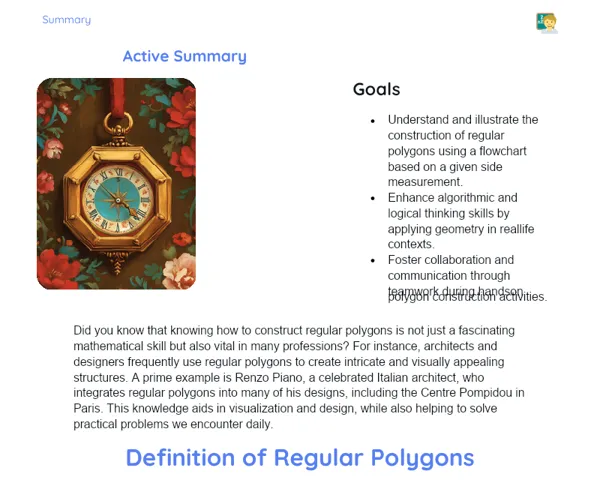Goals
1. Identify and define polygons, recognizing their basic elements such as vertices, sides, and angles.
2. Differentiate between various polygons, emphasizing their unique features and commonalities.
3. Ignite students' enthusiasm for studying geometric shapes and their real-world uses.
Contextualization
Polygons are all around us in everyday life. From road signs to the architectural designs of our buildings, geometric shapes are vital in crafting and shaping our surroundings. When we understand how these shapes work, we can tackle real-world problems more effectively. For instance, civil engineers utilize polygons when designing roads and bridges to ensure safety and practicality. Architects employ polygons to create both beautiful and functional designs, while graphic designers rely on them to make vector images that can be resized without losing their quality.
Subject Relevance
To Remember!
Definition and Recognition of Polygons
A polygon is a flat geometric figure created by connecting a series of line segments that form a closed shape. Polygons are categorized based on their number of sides, with each side being a line segment that links two consecutive vertices.
-
Polygons are flat shapes created from line segments.
-
The connecting line segments are called sides.
-
Where two sides meet are known as vertices.
-
Polygons are classified by the number of sides: triangle (3 sides), quadrilateral (4 sides), pentagon (5 sides), etc.
Constituent Elements of Polygons
The key elements of polygons include vertices, sides, and angles. Vertices are where two sides meet, sides are the segments creating the boundary of the polygon, and internal angles are found between two adjacent sides.
-
Vertices: Where two sides meet.
-
Sides: The segments forming the boundary.
-
Internal angles: Angles between adjacent sides.
Comparing Different Polygons
When we compare different polygons, we examine their distinct characteristics such as the number of sides, internal angles, and symmetry. Regular polygons have all sides and angles equal, whereas irregular polygons feature sides and angles of varying lengths and measures.
-
Regular polygons: All sides and angles are equal.
-
Irregular polygons: Sides and angles vary in length and measure.
-
Triangles, quadrilaterals, and pentagons are examples of polygons with 3, 4, and 5 sides, respectively.
Practical Applications
-
Architecture: Polygons are key in designing buildings and urban layouts to ensure that they are both practical and visually appealing.
-
Engineering: Polygons are crucial in the design of structures like bridges and roads, ensuring the safety and effectiveness of constructions.
-
Graphic Design: Polygons are used to create vector images that can be scaled without losing clarity.
Key Terms
-
Polygon: A flat geometric figure made from line segments that connect to form a closed shape.
-
Vertex: The meeting point of two consecutive sides of a polygon.
-
Side: A line segment that forms the outline of a polygon.
-
Internal Angle: An angle between two adjacent sides in a polygon.
-
Regular Polygon: A polygon with equal sides and angles.
-
Irregular Polygon: A polygon with sides and angles of different lengths and measures.
Questions for Reflections
-
How can we apply our understanding of polygons to other subjects apart from mathematics?
-
In what ways do polygons influence the design and construction of everyday objects?
-
What are the pros and cons of using regular versus irregular polygons in engineering and architectural projects?
Design Your Own Geometric City
In this mini-challenge, you’ll get the chance to put your understanding of polygons to the test by creating your own geometric city. Incorporate various types of polygons in your designs for buildings, parks, roads, and more.
Instructions
-
Collect the necessary materials: colored paper, ruler, scissors, glue, and a large poster board.
-
Sketch out a plan for your city, deciding which polygons to use for different structures (for example, using triangles for roofs and squares for buildings).
-
Draw and cut out the polygons according to your design.
-
Glue the polygons on the poster board to construct your city.
-
Once done, reflect on the polygon choices you made and discuss how they enhance both the function and beauty of the city.



